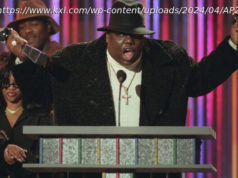A work by the Arkansas-born composer Florence Price, and a performance by Vikingur Olafsson were among the highlights.
In addition to writing reviews, features and news during the week, our critics and reporters offer a glimpse into the research we’ ve done on YouTube. Read the rest of our classical music coverage here. Mystical Musical Orgasm
David Lang’s “just (after song of songs) , ” from 2014, which I first encountered at the Tanglewood Festival of Contemporary Music on Sunday, is an exercise in mesmerizing simplicity and a wallow in gorgeous intimacy. Three female vocalists enumerate attributes and possessions of two lovers, drawn from the biblical Song of Songs, in short-breathed phrases with discreet instrumentation gradually added. The male’s utterances begin with the words “just your…” and descend; the female’s start with “and my …” and often rise. The few times the lovers speak together (“our …”) , the music takes on a sort of orgasmic shudder, as understated as the rest. JAMES R. OESTREICH
Read our review of Tanglewood’s Festival of Contemporary Music. Bleak, Gentle and Sweet
The most daring presentation of this summer’s Mostly Mozart festival was “The Dark Mirror, ” a musical-theatrical adaptation of Schubert’s “Winterreise.” Using the composer Hans Zender’s orchestration of the original piano part (which I found riveting) , the director Netia Jones created an almost cinematic staging of the cycle for the tenor Ian Bostridge. For an alternative staging, here is the director David Alden’s stark, ominous film version, with Mr. Bostridge and pianist Julius Drake. Catch the moment toward the end of the opening song when the minor-key music shifts to major and the camera zooms in on Mr. Bostridge. The setting is bleak, but the singing gentle and sweet. It’s utterly wrenching. ANTHONY TOMMASINI
Read our review of the staging. Not Defeat, But Triumph
In 1927, in the wake of the lynching of a young black man outside the Bethel A. M. E. church in Little Rock, the Arkansas-born composer Florence Price moved her family north. Six years later, with the premiere of her Symphony in E Minor by the Chicago Symphony Orchestra, Price became the first black woman to have a large-scale work performed by a major American orchestra. As the musicologist Rae Linda Brown has written, “Marginalized in her occupation by gender and race, Price persevered, and her story is not one of defeat but one of triumph specific to African-American women.” I was reminded of Price’s life and music last weekend, as white supremacists marched in Charlottesville, Va.; I turned to the slow movement of her pathbreaking 1933 symphony, a regal hymn that echoes the Largo of Dvorak’s “New World.” The movement concludes in poised splendor, as the main hymn theme returns in the brass, serenely punctuated by bells, with the clarinet unraveling eloquent counterpoint. WILLIAM ROBIN A Surprise Aida
The hashtag Jennifer Lindsey uses to describe her dual career as a violinist and singer is #sopranolinist. On Wednesday she got to embody it fully when, in the midst of an open dress rehearsal for Verdi’s “Aida” in California, the leading lady failed to appear for an entrance. Ms. Lindsey, who was both an understudy for the title role and a member of the orchestra’s violin section, rose to her feet, instrument in hand, and delivered a performance that wowed audience members and colleagues. CORINNA da FONSECA-WOLLHEIM Iceland’s Glenn Gould
Vikingur Olafsson made his Mostly Mozart festival debut recently with a late-evening recital at the Kaplan Penthouse, part of the popular Little Night Music series. He has gained attention for his brilliant performances and recording (on Deutsche Grammophon) of Philip Glass’s piano études. His captivating accounts of six of them showed why. I was equally impressed, though, by his fleet, free-ranging performance of Bach’s thorny Sixth Partita. Here he is in 2011 playing the work’s Rondeaux of the Second Partita. He takes it at a breathlessly fast tempo, yet plays with crispness and clarity and never seems hard-pressed, even in a finger-entangling passage about halfway through. In this moment, Mr. Olafsson sounds like Iceland’s Glenn Gould. ANTHONY TOMMASINI
Read our interview with Mr. Olafsson, and watch him perform on Facebook Live. Busman’s Holiday
For some, listening to music of the pioneering atonalists Schoenberg and Webern can be hard work, scarcely ideal for a vacation, but if the performances are expert and committed, it can be a joy. The San Francisco Bay Area-based Telegraph Quartet’s performances on YouTube were enough to persuade me to trek from Bar Harbor, Me., to nearby Blue Hill on Sunday to hear the ensemble play Schoenberg’s (tonal) String Quartet No. 1 and Webern’s Rondo at Kneisel Hall. The group’s traversal of the Five Movements by the master miniaturist Webern here is very fine, too. Check out the scherzo-like gem of a third movement, and it may make you, too, hungry for more. JAMES R. OESTREICH The Other Schumann Concerto
Kirill Gerstein, performing at the Mostly Mozart festival this week, followed Robert Schumann’s Piano Concerto in A minor with a brief encore: not a showy crowd-pleaser, but the lovely second movement of Clara Schumann’s Concerto in A minor. She wrote the piece when she was only 14, with orchestration help from Robert Schumann, who later became her husband. (She played the solo part in the premiere, which was conducted by Felix Mendelssohn.) The concerto is clearly the work of a young musician — it has more beauty than depth — but the second movement’s duet for piano and cello, in its lyricism and smart understanding of the two instruments’ voices, shows the promise of a composer headed for greatness. JOSHUA BARONE
Watch our Facebook Live concert and interview with Mr. Gerstein. Portrait of a Future Wife
Mr. Gerstein’s exploration of the relationship between Brahms and the Schumanns started in a concert with the Mostly Mozart festival’s orchestra, then continued in an intimate recital later that evening at the Kaplan Penthouse. Here is Mr. Gerstein in 2013 playing Schumann’s “Carnaval, ” one of my favorite of the composer’s inventive piano suites (and, judging from this fanciful and brilliant performance, one of Mr. Gerstein’s as well) . Listen to the section titled “Chiarina, ” a musical portrait of Clara, who was going on 16 at the time.
Home
United States
USA — Music Bleak, Gentle and Sweet: This Week’s 8 Best Classical Music Moments on...






